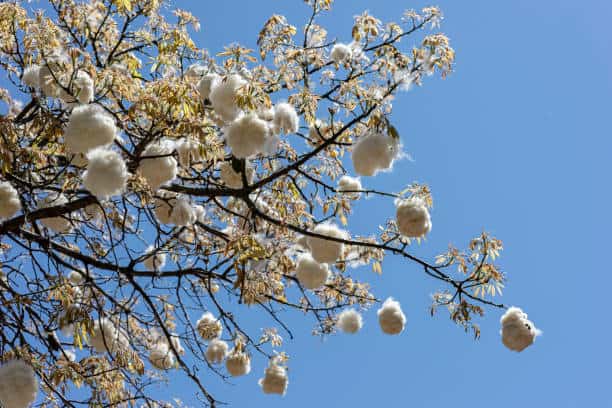The Magical World of Cotton Trees: A Delightful Exploration for Parents and Kids
Hello there, wonderful parents! Are you ready to embark on a fluffy and fascinating journey with your little ones? Today, we’re going to explore the enchanting world of cotton trees – those spectacular plants that seem like they’re straight out of a fairy tale! ??
Cotton trees, not to be confused with the plants that produce the cotton we use in clothes (that’s the cotton plant!), are actually a type of tree that are known for their seed pods which burst open to reveal cotton-like fluff. They’re scientifically known as Ceiba pentandra, but we’ll just keep it friendly and call them cotton trees. This guide is your ticket to understanding everything about these trees, from their ecology to how you can introduce their wonders to your kids.
What Exactly Are Cotton Trees?
Cotton trees are majestic giants that can tower up to 200 feet tall, and they have a large, thorn-covered trunk that can captivate anyone’s attention. They’re native to the tropical rainforest regions, but don’t worry, you don’t have to pack your bags and jet off to the Amazon to see them. You can often find these trees in local botanical gardens or even some parks, depending on where you live.
With their wide, spreading branches and enormous umbrella-like canopy, they’re like the friendly giants of the tree world. And when their seed pods ripen, they burst open to release seeds surrounded by a cloud of fluffy, cotton-like fibers – it’s like nature’s very own version of a pillow fight!
Why Are Cotton Trees Special?
There’s something inherently whimsical about cotton trees that sparks the imagination. Not only are they a sight to behold, but they also play an important role in their ecosystems. They stand as sentinels for biodiversity, providing homes and food for a variety of animals, from birds to monkeys. Their fluff has been used as stuffing for pillows and mattresses long before modern synthetic materials came into play. And for the little eco-warriors in your family, learning about cotton trees can be a beautiful lesson in environmental importance.
But it’s not just their ecological role that’s exciting. Cotton trees have also weaved their way into folklore and historical narratives around the world, from being considered sacred in some cultures to being rumored to house spirits in their massive trunks. Imagine the stories you can share during family time!
Introducing Cotton Trees to Your Kids
Now, how can you introduce these gentle giants to your youngsters? Children are naturally curious, and cotton trees are a great way to nurture their interest in nature. Start with a visit to a local botanical garden or a park where they can see these trees up close. Let them touch the bark, watch for wildlife that calls these trees home, and if you’re lucky, find a fallen seed pod to explore the cotton-like fibers inside.
At home, you can extend this learning experience by engaging in cotton tree crafts. Use some cotton balls to create fluffy tree art, or if you snagged a seed pod, inspect and plant the seeds together and watch as the magic of growth unfolds. It’s hands-on, it’s creative, and most importantly, it’s a fun bonding activity!
Don’t forget to check out the fabulous range of children’s books that feature cotton trees. Reading to your kiddos about these trees can help instill deeper understanding and appreciation for nature’s marvels. Plus, who doesn’t love a good story time?
Are you already picturing the fun adventures ahead? We are just scratching the surface here, but don’t worry, there’s plenty more to discover about cotton trees. From taking care of cotton tree saplings to turning your encounters with these trees into teachable moments on biodiversity, this guide will keep you covered.
So grab your explorer’s hat and let’s get ready to share the love for cotton trees with the next generation. Join us as we continue to delve deeper into this topic in the following sections, ensuring you have all the tools you need to transform your kiddo into a mini botanist in no time!
Stay tuned, because our adventure with cotton trees is just beginning, and there’s so much more to learn and explore. Get ready to inspire a sense of wonder and responsibility for nature in your children – it’s going to be an amazing ride!

5 Things Parents Should Know When Preparing for Cotton Trees
1. Understanding the Growing Conditions
First things first, let’s talk about creating the perfect environment for these trees. Cotton trees thrive in warm climates and prefer well-drained soil. Although they can withstand brief periods of drought once mature, young trees need a bit more TLC. Regular watering and protection from harsh conditions are essential until they firmly root themselves. If you’re considering planting a cotton tree, ensure you have enough space because these trees can grow really large!
2. The Importance of Patience
Just like nurturing a child, growing a cotton tree takes patience and time. They may take several years to mature and produce the characteristic fluffy seed pods. It’s an opportunity to teach your kids about patience and the rewards of tending to nature. You get to observe the slow yet remarkable progression from a small seedling to a magnificent tree together. It’s a profound lesson on the importance of nurturing and caring for the environment over time.
3. Safety First
While exploring and planting cotton trees can be a great family activity, it’s essential to remember that their trunks are covered with thorns that can be quite sharp. Always supervise your children around these trees and use this as an opportunity to teach them about respecting nature and understanding that some plants, while beautiful, need to be handled with care.
4. Allergies and Cleaning Up
The fluff from cotton trees is enchanting, but it’s not always friendly to those with allergies. Make sure none of your family members are allergic to the fibers. Moreover, be ready for some cleanup. When the seed pods burst, they can create quite the fluff-filled spectacle, which might require some raking and yard maintenance.
5. Inclusion in Curriculum and Extra-Curricular Activities
Engaging in school projects about cotton trees can be a fantastic way for kids to hone their academic and research skills. Encourage your children to include what they’ve learnt about cotton trees in their school science projects or select it as a topic for an interesting presentation. Many schools admire hands-on learning, and your little ones could even bring seed pods to class, fostering interactive and communal learning.
Embracing the world of cotton trees is a long-term commitment, full of learning opportunities, responsibilities, and joys. Remember, you’re not just growing a tree; you’re cultivating a growing mind’s connection to nature. So, cherish each step of this green journey with your kiddos – the sense of accomplishment you’ll feel as a family when those first fluffs appear is utterly priceless!
The journey through the world of cotton trees doesn’t stop here. There are countless ways to involve your children in the care and understanding of these magnificent plants. These steps are just the beginning. By informing yourself and preparing for the responsibilities that come with these fantastic flora, you will not only enrich your own knowledge but also pass on invaluable lessons to the little ones in your life. After all, learning about cotton trees isn’t just educational – it’s an adventure for the whole family!
And with that, let’s continue our fluff-filled journey of discovery. There’s still so much to uncover about cotton trees – from their intricate life cycles to their symbiotic relationships with the wildlife that depends on them. Ready your green thumbs and inquisitive minds, my dear parents, and let’s dive even deeper into the world of these fluffy wonders!
For more great fun click here. For more information see here
Disclaimer
The articles available via our website provide general information only and we strongly urge readers to exercise caution and conduct their own thorough research and fact-checking. The information presented should not be taken as absolute truth, and, to the maximum extent permitted by law, we will not be held liable for any inaccuracies or errors in the content. It is essential for individuals to independently verify and validate the information before making any decisions or taking any actions based on the articles.




